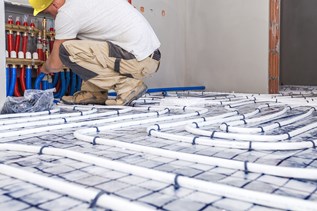The history of underfloor heating
17 August 2023
Once seen as a luxury, underfloor heating is becoming more widespread and accessible. It is now a popular choice for new-builds and can also be retrofitted in the majority of buildings.
What’s more, underfloor heating installations are much cheaper than they used to be. Not only this, but there are a wide variety of systems to choose from, making it versatile and economical.
Not to mention the advantages of this low carbon technology. By using underfloor heating, your carbon footprint will decrease, thanks to its low carbon usage. As underfloor heating has an average temperature of 50°C with a return temperature of 43°C, it is much more energy efficient and economical to run compared to a radiator’s average temperature of 70°C.
Another reason why underfloor heating is becoming increasingly popular is its low maintenance. As the system runs at a consistently low temperature, it rarely breaks, making it an easy and cost-effective system to maintain.

Underfloor heating during 5000 BC Korea
Underfloor heating dates back as far a 5000 BC, where it was invented in Korea. Floors were heated via an extended flue system, which connected every room of the home via a horizontal flame. When a fire was lit for cooking, this flame would extend through the flue system, via passages, heating up each floor in the home. This system is called an ondol.
The ondol then progressed as, in 900 BC, it is noted that a double hearth system was used, one for cooking and the other for heating.
Underfloor heating during the Middle Ages
Fast forward to 500 BC, the Romans and Greeks brought underfloor heating to Europe. They installed this by raising the floor on pillars, where hot air passed through underneath. This is known as a hypocaust, and was a popular system choice throughout the Middle Ages.
What’s more, the Romans and Greeks preferred using an open fire system compared to the Asian preference for the ondol. It was also widely used amongst the upper classes, and was installed in the renowned public baths across the continent.
Most prominently, hypocausts were extensively and sophisticatedly used in Turkish Baths, which were built during the Ottoman Empire.
How underfloor heating has evolved
During the 19th Century, boilers and the central heating systems that we use today were becoming more widespread across Europe. It was during this time that polymethylene was accidentally discovered. At first, it was discarded but has since become the most widely used plastic in the world.
Fast-forward to the 20th Century, polymethylene, now coined polyethylene, was the most popular material used for pipes in a water underfloor heating system in 1965.
Throughout the 20th Century, underfloor heating evolved throughout Europe and North America. Alongside this, the use of plastics improved, which then improved water underfloor heating.
By the 1980s, water underfloor heating became a common form of residential heating throughout Scandinavia and parts of the USA.
So, whilst underfloor heating seems like a new phenomenon, it’s actually been a staple form of heating since 5000 BC.
From Korea to Scandinavia, underfloor heating has been used both in the home and in non-residential areas since the 20th Century. So, it’s no wonder why this form of heating keeps increasing in popularity.

What Swale Heating can do for you
With such an increase in the use of underfloor heating, Swale Heating are a first-choice in the installation and maintenance of this system.
Our engineers are experts in both water and electric underfloor heating installations, so you can be safe in the knowledge that your underfloor heating has been installed safely and properly. Feel free to read more about underfloor heating on our website.
If you’re thinking about getting underfloor heating, call free on 0800 731 3344 to speak to one of our Sales team today.